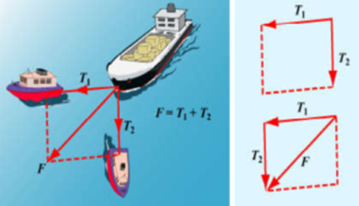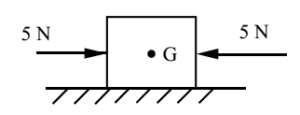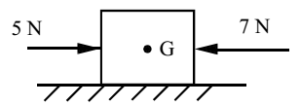Science > Physics > Force > Concept of Balanced and Unbalanced Forces
In this article, we shall discuss the concept of balanced forces and unbalanced forces.
Kinematics: The branch of physics (mechanics) which deals with the motion of the bodies without considering the forces causing it is called kinematics.
Dynamics: The branch of physics (mechanics) which deals with the motion of the bodies and the forces causing it is called dynamics.
Concept of the Resultant Force:

Two forces T1 and T2 are applied by two tug boats on a ship at an angle to each other. As a result, the ship accelerates and moves in the direction as shown, as if it were under the influence of a single force F. The single force which acts on a body to produce the same effect in it as is done by all the forces collectively is called a resultant force.
Balanced Force:

When a number of forces acting on a body do not cause any change in the state of rest or of uniform motion in a straight line, then the resultant force acting on the body is said to be zero and the forces are said to be balanced forces. From this explanation, we can conclude that a state of rest or of uniform motion in a straight line, does not mean no force acts on a body. Actually a number of forces may be acting on it but they are balanced forces. Thus balanced forces do not change the state of motion of a body, but they may change the shape of the body.
Unbalanced Force:

When the resultant of all the forces acting on a body is not zero, then the forces are said to be unbalanced forces. Unbalanced forces cause the change of state of motion of a body.
Aristotle (384 BC – 322 BC):

Aristotle was a Greek philosopher, a student of Plato and teacher of Alexander the Great. His writings cover many subjects, including poetry, physics, metaphysics, theater, music, logic, rhetoric, linguistics, politics, ethics, government, biology, and zoology. Together with Plato and Socrates (Plato’s teacher), Aristotle is one of the most important founding figures in Western philosophy. Aristotle’s writings were the first to create a comprehensive system of Western philosophy, encompassing morality and aesthetics, logic and science, politics and metaphysics.
Aristotle’s Concept of motion:
Aristotle proposed that for uniform motion a constant force is required. Thus to move a body at rest we have to apply force and to make the body to be in continued motion we have to apply constant pressure. When this constant force ceases to act, the body stops. This concept was accepted and believed for about 2000 years.
Galileo Galilei (15 February 1564 – 8 January 1642):

Galileo Galilei was an Italian physicist, mathematician, astronomer, and philosopher who played a major role in the Scientific Revolution. His achievements include improvements to the telescope and consequent astronomical observations and support for Copernicanism. Galileo has been called the “father of modern observational astronomy”. Stephen Hawking says, “Galileo, perhaps more than any other single person, was responsible for the birth of modern science.
The motion of uniformly accelerated objects, taught in nearly all high school and introductory college physics courses, was studied by Galileo as the subject of kinematics. His contributions to observational astronomy include the telescopic confirmation of the phases of Venus, the discovery of the four largest satellites of Jupiter (named the Galilean moons in his honour), and the observation and analysis of sunspots. Galileo also worked in applied science and technology, inventing an improved military compass and other instruments.
Before Galileo, it was assumed that if a heavy body and a light body are dropped from the same height simultaneously, then the heavier body will strike the ground first. Galileo by his experiments at leaning tower Pisa proved that irrespective of their masses, both the body hit the ground simultaneously. He proposed that all the bodies are attracted to the earth by constant acceleration. His work is a base for Newton’s law of motion and Newton’s law of gravitation.
The geocentric concept of the universe was accepted at that time i.e. all planets and stars revolve around the earth. Copernicus proposed heliocentric theory i.e. sun at the centre and the earth and other planets revolve around the sun. Copernicus was punished to death for proposing theory opposite to religious beliefs. Galileo was punished by the Catholic Church for supporting Copernicus heliocentric theory and was forbidden from teaching and holding any talks. Ban on him was lifted when he apologized to the church.
Galileo’s Concept of Motion:
Galileo proposed that “For uniform motion, no force is required. Force is only required to change the state of motion”. He proved it with his Marble-Tray Experiments.
Galileo’s Experiments:
For his experiment Galileo used double inclined plane one sloping down, one sloping up. He released the marble from the sloping down plane he found that the velocity of the marble increases then the marble moves up sloping up the inclined plane. When moving up the velocity of the marble decreases. It reaches the same height on sloping up the inclined plane from which it is released from sloping down the inclined plane.

Now, he decreased the angle of sloping up the inclined plane and released the marble from the same height. He observed that the marble reaches the same height covering a longer distance.

Then he made sloping up the plane completely horizontal and released the marble from the same height. He observed that marble travels larger distances and he said that the marble will be in motion continuously (will cover infinite distance) as it will never reach that height.

When the surface of the second plane is rough, the ball would cover less distance. Thus, the conclusion of the experiment was that for uniform motion no force is required. This was the basis of Newton’s laws of motion.
Note: Actually the marble cannot move forever because it stops due to the friction between it and the surface.
Thus by this experiment, Galileo proved that for uniform motion no unbalanced forces are required.
Previous Topic: Types of Forces
Next Topic: Newton’s First Law of Motion
